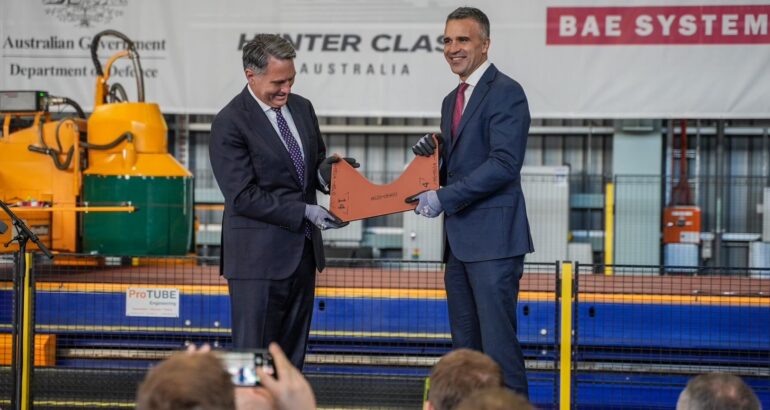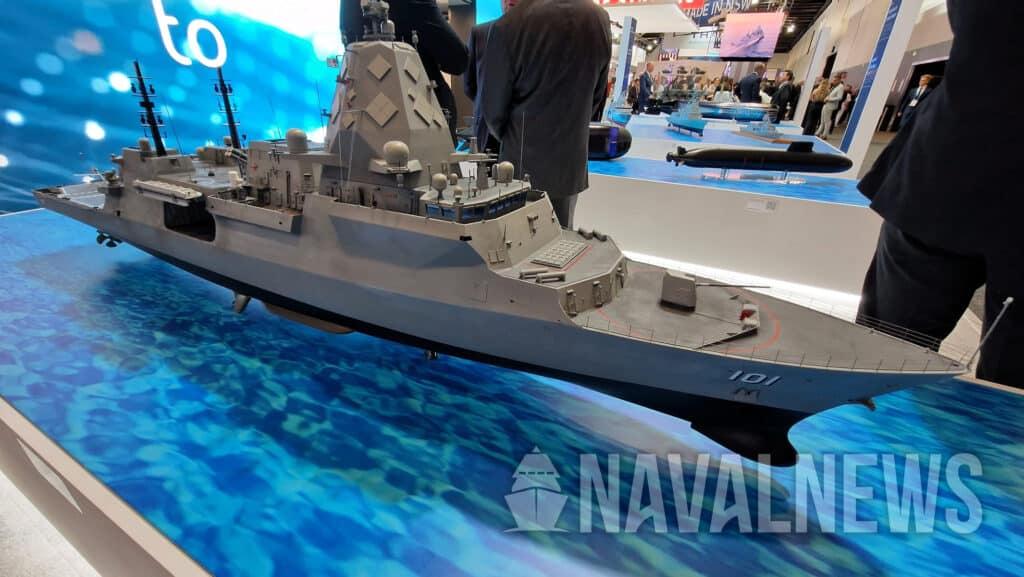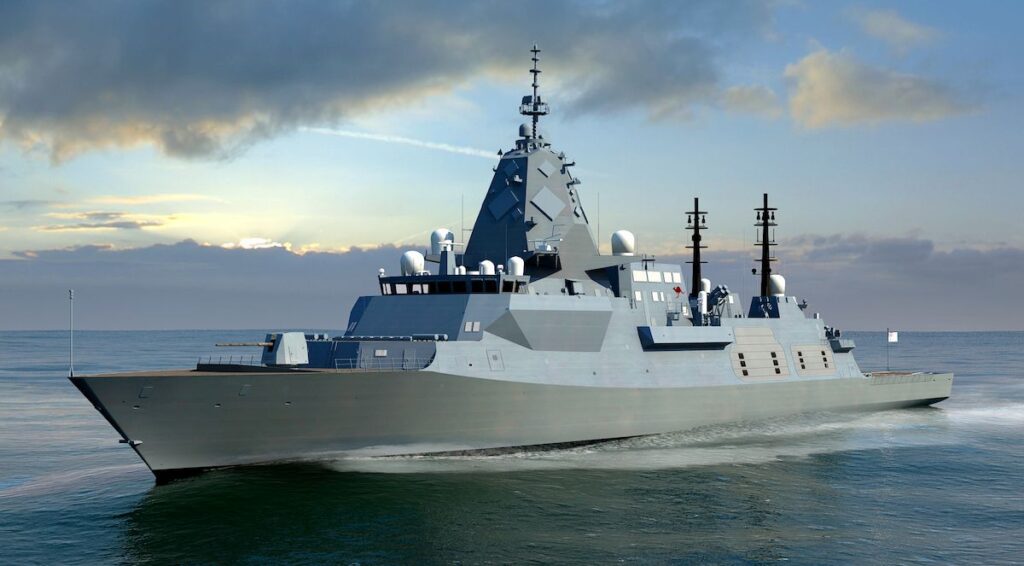Australia Cuts Steel on its First Hunter-class Frigate

Steel cutting ceremony for the first Hunter-class frigate. Government of South Australia picture.
Australia Department of Defence press release
Today, the Albanese Government has taken another significant step in delivering Navy’s enhanced lethality surface combatant fleet with construction commencing on the first Hunter Class Frigate.
This major milestone was marked by the Deputy Prime Minister and the Premier of South Australia cutting the first piece of steel to be used on the first ship of the class.
Earlier this year, the Albanese Government announced the most significant investment in Navy’s surface fleet in decades. This included a commitment to build six Hunter class frigates in South Australia to significantly improve Navy’s undersea warfare and strike capability.
The contract for the construction phase for the first three Hunter Class Frigates has now been signed by Defence and BAE Systems Australia, with the first Hunter Class Frigate expected to be operational in 2034.
Construction of the Hunter Class Frigates will take place at the Osborne Naval Shipyard as part of the Albanese Government’s commitment to continuous naval shipbuilding in South Australia.
The construction phase of the Hunter Class Frigate Program will run for 20 years.
At its peak this program will support around 3,000 direct jobs and will support a further 5,000 indirect jobs across the Australian supply chain.
These jobs are in addition to the thousands of highly skilled workers that will be required to build our AUKUS submarines and extend the life of the Collins class submarines, both of which will also take place at Osborne in South Australia.
The Hunter Class Frigates are a key component of the Albanese Government’s commitment to ensure the Royal Australian Navy has a surface fleet with high levels of lethality and deterrence in a time of increased global uncertainty.
Deputy Prime Minister, the Hon Richard Marles MP, said:
“This first milestone is not just about cutting steel; we are supporting Australian workers to build frigates in an Australian yard, supporting Australian industry.
“Continuous naval shipbuilding is how Australia will grow its shipbuilding and sustainment workforce, industry, and infrastructure.
“This milestone exemplifies our government’s commitment to deliver continuous naval shipbuilding in South Australia and a future made in Australia, by Australians.
“This project will support highly skilled Australian jobs, including around 3,000 direct jobs at its peak and a further 5,000 indirect jobs through the Australia supply chain.”
Premier of South Australia, Peter Malinauskas, said:
“This is a momentous day for our state.
“The construction of the frigates locks in a pipeline of continuous naval shipbuilding in South Australia, delivering thousands of secure, well paid jobs for generations to come.
“This delivery of frigates alongside SSN-AUKUS submarines puts South Australia front and centre in the most crucial of national endeavors.
“It also represents a step change in our state’s economic complexity, which will help improve the standard of living for South Australians more broadly.”
-End-
 Hunter-class frigate scale model on BAE Systems booth at IndoPacific 2023.
Hunter-class frigate scale model on BAE Systems booth at IndoPacific 2023.
BAE Systems Australia press release
The Commonwealth of Australia has awarded BAE Systems Maritime Australia a contract to build the first three Hunter class frigates as the program celebrates its transition into formal construction phase.
Deputy Prime Minister, Richard Marles and the Premier of South Australia, Peter Malinauskas, officially cut steel on the first ship at a ceremony at the Osborne Naval Shipyard in Adelaide, South Australia.
The event was attended by representatives from Federal and State Governments and the Royal Australian Navy, as well as BAE Systems Australia industry partners, suppliers and employees.
The piece of steel cut forms part of the under structure support for the port side propeller shaft brake system.
Based on the Type 26 Global Combat Ship, the first four of which are under construction at BAE Systems’ site in Glasgow, UK, Hunter is one of the world’s most advanced anti-submarine warfare frigates and will provide the Royal Australian Navy with next-generation capability.
Ben Hudson, Chief Executive Officer, BAE Systems Australia, said:
“This is a proud moment for all of us at BAE Systems Australia and it comes at a time when the capability of Hunter has never been more important.
“Hunter will be one of the most technologically advanced, stealth-capable anti-submarine warfare vessels in the world and its modular mission bay allows it to undertake a wide-range of missions from warfare to humanitarian and disaster relief.
“Over the coming years we will build and deliver the first three Hunter class frigates to the Royal Australian Navy.”
Craig Lockhart, Managing Director, BAE Systems Australia – Maritime, said:
“We already have a head-start on the construction of the first Hunter class frigate, with six schedule protection blocks already in production approved under the design and productionisation phase as part of the risk mitigation strategy.
“This program has always been more than just building ships, we have created world-leading facilities, a vibrant supply chain ready to step up to full rate of production and a workforce that is proving it can produce the highest quality shipbuilding products that can compete anywhere.
“This moment has been a long time in the making and it has been a tremendous journey so far, but we have demonstrated that together with our partners, suppliers and the great team both here at Osborne and in the UK, we are up to the task and raring to go.”
-End-
 BAE Systems
BAE Systems
Naval News comments:
A review into Australia’s procurement of the Hunter class frigate (issued in January) has found serious issues with the procurement process that led to the BAE Systems Type 26 design being selected for the Royal Australian Navy’s future frigates.
Subsequently, the Australian government on February 20 released a long awaited response outlining intentions for modernization and expansion of the RAN surface fleet. As a result, the Hunter-class program has been reduced from 9 to 6 ships. Together with the Hobart-class AAW-destroyers, the vessels are now classified as “Tier 1”combatants for the future fleet mix. In line with this perception Canberra intends to cut Hunter short at six instead of nine hulls. A “lower end”- or “Tier 2”-design has emerged as new effort to come true on the requirement for an additional ANZAC-successor and growing the RAN surface fleet.
The first Hunter will now be delivered to the RAN in 2032, with the final vessel delivered in the early-2040s.
Hunter-class frigate specifications:
Displacement: 8,800 t full load
Length: 151.4 m (496 ft 9 in)
Beam: 21.4 m (70 ft 3 in)
Propulsion: CODLOG configuration
Speed: 27+ knots
Range: 7,000 nautical miles
Complement: 180 sailors (accommodation for 208)

Steel cutting ceremony for the first Hunter-class frigate. Government of South Australia picture.
Australia Cuts Steel On Its First Hunter-Class Frigate
Australia's future Hunter-class of frigates took a significant step forward today, when BAE Systems cut steel on the first of six vessels at the Osborne Naval Shipyard in Adelaide, South Australia.
Naval News Staff 21 Jun 2024Australia Department of Defence press release
Today, the Albanese Government has taken another significant step in delivering Navy’s enhanced lethality surface combatant fleet with construction commencing on the first Hunter Class Frigate.
This major milestone was marked by the Deputy Prime Minister and the Premier of South Australia cutting the first piece of steel to be used on the first ship of the class.
Earlier this year, the Albanese Government announced the most significant investment in Navy’s surface fleet in decades. This included a commitment to build six Hunter class frigates in South Australia to significantly improve Navy’s undersea warfare and strike capability.
The contract for the construction phase for the first three Hunter Class Frigates has now been signed by Defence and BAE Systems Australia, with the first Hunter Class Frigate expected to be operational in 2034.
Construction of the Hunter Class Frigates will take place at the Osborne Naval Shipyard as part of the Albanese Government’s commitment to continuous naval shipbuilding in South Australia.
The construction phase of the Hunter Class Frigate Program will run for 20 years.
At its peak this program will support around 3,000 direct jobs and will support a further 5,000 indirect jobs across the Australian supply chain.
These jobs are in addition to the thousands of highly skilled workers that will be required to build our AUKUS submarines and extend the life of the Collins class submarines, both of which will also take place at Osborne in South Australia.
The Hunter Class Frigates are a key component of the Albanese Government’s commitment to ensure the Royal Australian Navy has a surface fleet with high levels of lethality and deterrence in a time of increased global uncertainty.
Deputy Prime Minister, the Hon Richard Marles MP, said:
“This first milestone is not just about cutting steel; we are supporting Australian workers to build frigates in an Australian yard, supporting Australian industry.
“Continuous naval shipbuilding is how Australia will grow its shipbuilding and sustainment workforce, industry, and infrastructure.
“This milestone exemplifies our government’s commitment to deliver continuous naval shipbuilding in South Australia and a future made in Australia, by Australians.
“This project will support highly skilled Australian jobs, including around 3,000 direct jobs at its peak and a further 5,000 indirect jobs through the Australia supply chain.”
Premier of South Australia, Peter Malinauskas, said:
“This is a momentous day for our state.
“The construction of the frigates locks in a pipeline of continuous naval shipbuilding in South Australia, delivering thousands of secure, well paid jobs for generations to come.
“This delivery of frigates alongside SSN-AUKUS submarines puts South Australia front and centre in the most crucial of national endeavors.
“It also represents a step change in our state’s economic complexity, which will help improve the standard of living for South Australians more broadly.”
-End-

BAE Systems Australia press release
The Commonwealth of Australia has awarded BAE Systems Maritime Australia a contract to build the first three Hunter class frigates as the program celebrates its transition into formal construction phase.
Deputy Prime Minister, Richard Marles and the Premier of South Australia, Peter Malinauskas, officially cut steel on the first ship at a ceremony at the Osborne Naval Shipyard in Adelaide, South Australia.
The event was attended by representatives from Federal and State Governments and the Royal Australian Navy, as well as BAE Systems Australia industry partners, suppliers and employees.
The piece of steel cut forms part of the under structure support for the port side propeller shaft brake system.
Based on the Type 26 Global Combat Ship, the first four of which are under construction at BAE Systems’ site in Glasgow, UK, Hunter is one of the world’s most advanced anti-submarine warfare frigates and will provide the Royal Australian Navy with next-generation capability.
Ben Hudson, Chief Executive Officer, BAE Systems Australia, said:
“This is a proud moment for all of us at BAE Systems Australia and it comes at a time when the capability of Hunter has never been more important.
“Hunter will be one of the most technologically advanced, stealth-capable anti-submarine warfare vessels in the world and its modular mission bay allows it to undertake a wide-range of missions from warfare to humanitarian and disaster relief.
“Over the coming years we will build and deliver the first three Hunter class frigates to the Royal Australian Navy.”
Craig Lockhart, Managing Director, BAE Systems Australia – Maritime, said:
“We already have a head-start on the construction of the first Hunter class frigate, with six schedule protection blocks already in production approved under the design and productionisation phase as part of the risk mitigation strategy.
“This program has always been more than just building ships, we have created world-leading facilities, a vibrant supply chain ready to step up to full rate of production and a workforce that is proving it can produce the highest quality shipbuilding products that can compete anywhere.
“This moment has been a long time in the making and it has been a tremendous journey so far, but we have demonstrated that together with our partners, suppliers and the great team both here at Osborne and in the UK, we are up to the task and raring to go.”
-End-

Naval News comments:
A review into Australia’s procurement of the Hunter class frigate (issued in January) has found serious issues with the procurement process that led to the BAE Systems Type 26 design being selected for the Royal Australian Navy’s future frigates.
Subsequently, the Australian government on February 20 released a long awaited response outlining intentions for modernization and expansion of the RAN surface fleet. As a result, the Hunter-class program has been reduced from 9 to 6 ships. Together with the Hobart-class AAW-destroyers, the vessels are now classified as “Tier 1”combatants for the future fleet mix. In line with this perception Canberra intends to cut Hunter short at six instead of nine hulls. A “lower end”- or “Tier 2”-design has emerged as new effort to come true on the requirement for an additional ANZAC-successor and growing the RAN surface fleet.
The first Hunter will now be delivered to the RAN in 2032, with the final vessel delivered in the early-2040s.
Hunter-class frigate specifications:
Displacement: 8,800 t full load
Length: 151.4 m (496 ft 9 in)
Beam: 21.4 m (70 ft 3 in)
Propulsion: CODLOG configuration
Speed: 27+ knots
Range: 7,000 nautical miles
Complement: 180 sailors (accommodation for 208)


